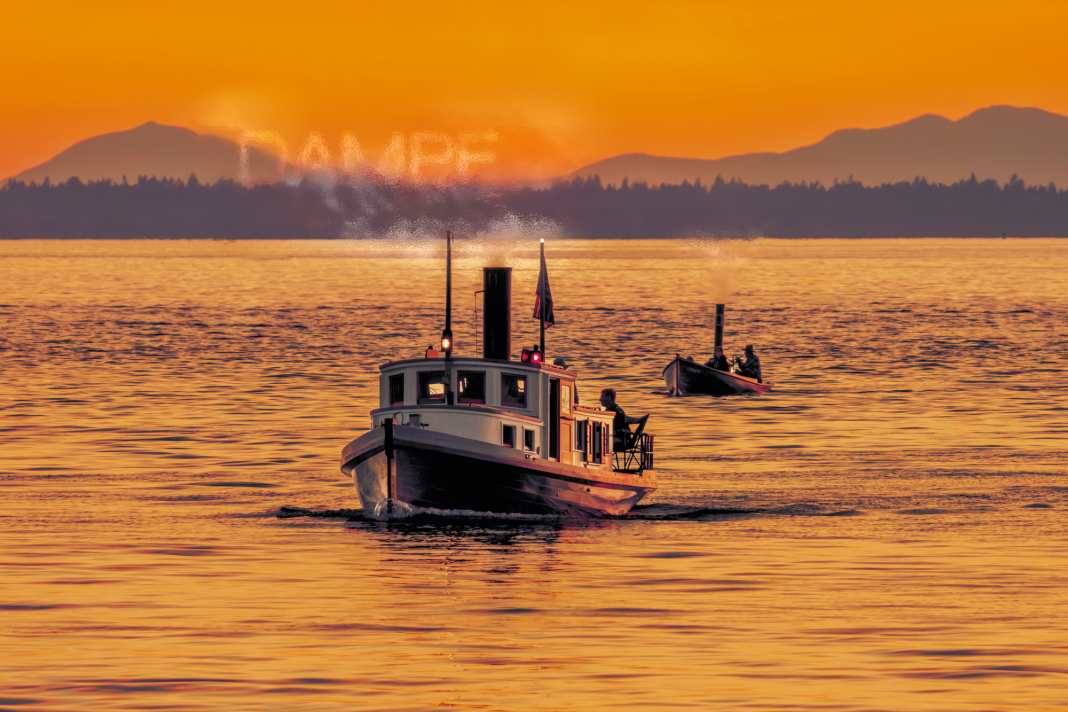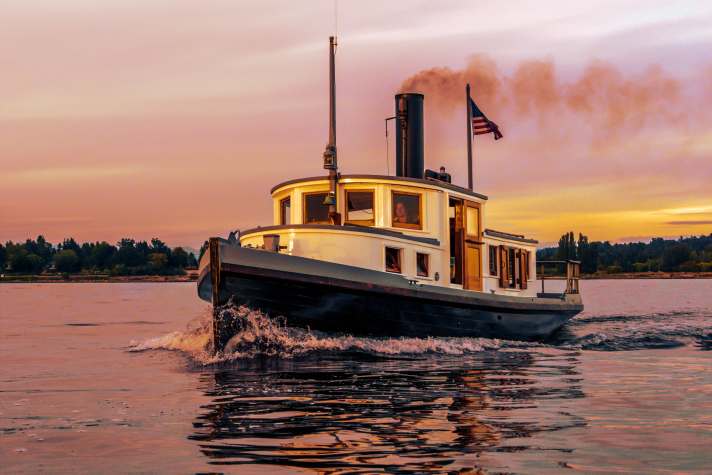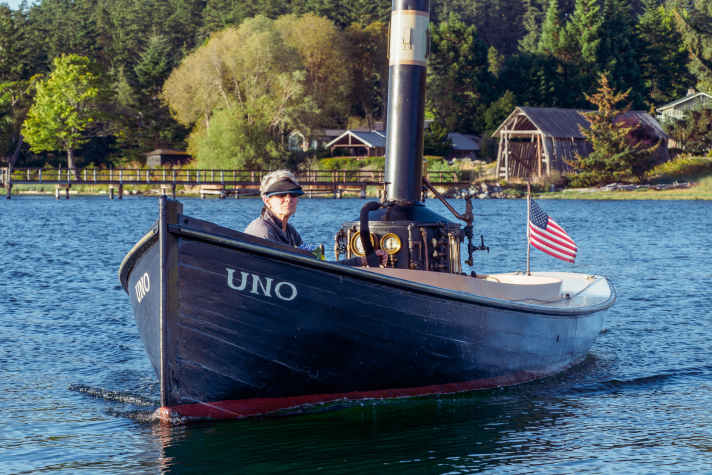Nostalgia meets modernity: Traditional steamboats - Northwest Steam Society celebrates 50 years
Dieter Loibner
· 11.01.2024






The sound of the whistles announces it loud and clear: the steamers are here! The sound of the whistles, once part of the harbour atmosphere, is a very special experience that inevitably brings a smile to your face. Steamboats have become a rarity, reminiscent of the times of the industrial revolution, but today they largely manage without coal shovels and black smoking chimneys. Nevertheless, the nostalgic magic of purely analogue technology remains. There are no hidden automatics, not to mention digital assistance systems. The external combustion drive is still all manual, and operating the steam boiler and engine, which are installed unobstructed in the centre of the ship, requires a great deal of attention. There is a hustle and bustle, but there is no room for rushing.
There is no room for steam power in the everyday life of the digital age, but the technology is far from being consigned to the scrap heap. This is ensured by associations that have dedicated themselves to the subject and work tirelessly to preserve and restore these vehicles. So on a bright blue summer weekend, 20 beautiful boats gather in Blaine in the US state of Washington on the border with Canada to celebrate the 50th anniversary of the Northwest Steam Society (NWSS). The public is invited to admire the ships and ask the owners questions. With a bit of luck, there will also be an opportunity to go for a ride.
Preserving the heritage of steamboats
It is the declared aim of the NWSS to preserve the tradition of steam power and the legacy of the Mosquito Fleet, whose ships held the transport monopoly in the Seattle area in the 19th and early 20th centuries until diesel and petrol engines took over. "People are surprised when they hear that steamships still exist," laughs John Hope. The 82-year-old is a former president of the NWSS, grew up in England in the 1940s and 1950s and still travelled to school on steam trains. Hope came to the USA in 1967 and worked at Boeing as Chief Engineer for Flight Simulation and Director of Flight Operations. "Today, US Navy aircraft carriers are still powered by steam heated by nuclear power," says Hope.
Traditional steamboats have nothing in common with nuclear energy, of course, but they also fire their boilers with diesel, which is easier to stow and takes up less space than coal or wood. These earlier energy sources are only used occasionally today. In most cases, two-cylinder compound steam engines are used, whereby steam from a boiler is fed to the engine via a supply line to move the pistons, shaft and propeller. Used steam is condensed into water and returned to the boiler via pipes, pumps, valves and a collecting tank.
Unmistakable soundscape
Anyone watching Paul Hylton as he steams up his traditional 11.30-metre Puget Sound tugboat "Dodo" with the wood-fired boiler gets a lesson in thermodynamics and mechanics, accompanied by a soundscape of whistling, hissing, creaking and gurgling. "Dodo", the 54-year-old explains, was launched near Seattle in 1934 after almost 20 years of construction by her designer and builder Harold Lanning. The ship's name is a subtle reference to the fact that steamships had already been anticipated to die out at the time. She was powered by a US Navy Type K engine (No. 1567), which is still in reliable service today - and again, see below.
As the largest boat at the meeting, "Dodo" can bunker up to 1.3 tonnes of firewood. Of course, this has to be felled, dried and cut to log length before it is meticulously stowed on board. No need to rush to the petrol or charging station. A full load of wood lasts for around 50 hours, with a consumption of around one American pound of wood per minute - equivalent to 425 grams - and a cruising speed of around 6.5 knots.
In operation, Hylton and his wife Emily share the duties, with him at the helm in the harbour while she fires the boiler, guided by his commands. However, as soon as open water is reached, the roles are swapped.
"These boats keep their crews on their toes," says Michael Cross. The retired mechanical engineer is the club's safety officer. Cross was a cruising sailor and sailed across the Pacific in self-built boats before he swapped tiller and sheet for the 8.5 metre steam launch "Amity". "You have to keep an eye on the fire, regulate the steam and know what's going to happen in 15 minutes." Unlike with conventional boat engines, where the power is simply supplied by the throttle, the stoker on steamboats has to generate the right steam pressure in good time, for example for harbour manoeuvres.
Investing time in steamboats
Older members in particular take a critical view of the planned wear and tear of current products. "We live in a throwaway society that craves instant gratification," says Dave Hogan, for example. The 78-year-old is one of the founders of the club and has been involved with steam technology since his childhood. "But anyone who maintains a steamboat needs time, should be able to repair things and understand something about craftsmanship. But fewer and fewer young people are learning this at school like they used to."
There is no sign of this in the engine room of the "Dodo". Hylton methodically operates various levers and valve wheels with an eye on the pressure gauge. A pressure of 120 pounds per square inch (psi), or about 8.2 bar, is required for leaking, with the safety valve set at 200 psi (about 14 bar). "Heating up takes about 45 minutes if you start with a cold boiler, but with residual heat from the last trip, it's quicker," Hylton explains. Also interesting: as no government agency feels responsible for the safety of private steam yachts, the club members support each other in carrying out safety tests such as pressure testing the boiler.
While the flames flicker in the firebox, Hylton grabs an oil can to lubricate all easily accessible moving parts such as eccentrics and joints with a few drops. He then opens two small metal boxes on the port side of the engine and pours in some oil, which is fed to the running engine in measured quantities via worsted wool wicks.
As the pistons of the steam engine begin to move, music is heard from the rhythmic clicking of the engine's precision-manufactured steel parts. Hylton now uses the reversing lever to demonstrate the stepless change from forwards to reverse. "Boat steam engines are usually connected directly to the propeller shaft via a clutch, there is no gearbox," explains Hubert Paulus, editor of "Das Dampfboot" magazine from the German Steamboat Association.
With its 20 hp engine, "Dodo" can run at 7.5 knots. It was already on board the former fishing vessel when it was built. After 50 years in original condition, the owner at the time converted to a diesel engine and sold the steam engine to the UK, where it lay unused for a quarter of a century.
Hylton acquired "Dodo", which he had admired since his youth, in 2008 with the intention of converting her back to steam power. As luck would have it, he was able to buy back her original engine at an internet auction in 2010.
Hylton commissioned a shipyard to replace the drives. As the wheelhouse was also to be overhauled and the structure refurbished, it ultimately took eight years before "Dodo" went back under steam with the Hyltons.
A second steamboat chapter
Their family history even has a second steamboat chapter, as there is also "Uno", an elegant, 6.8 metre long steam launch with a black wooden hull, which has been owned by Hylton's aunt Stephanie for 50 years. She lives on nearby Lopez Island and is, of course, also involved in the steamboat club. "Uno" is one of the oldest boats in service in the USA. It was built in 1894 by a Norwegian immigrant as a rowing and sailing boat from local timber.
"Back then, it was the equivalent of a pick-up truck and was used to transport goods from island to island," says owner Stephanie, who is preparing the ship for its 130th anniversary celebrations and lists several metamorphoses: The rudder and sails were replaced by a petrol engine in 1906, which at some point gave way to a more powerful engine, probably for rum smuggling from Canada. One day, the boat was seized and confiscated by the US authorities, who in turn used it to hunt smugglers.
A private owner finally converted her to steam in the 1960s before Stephanie Hylton acquired her in 1973. In 2002, she had a Stuart-Turner twin-cylinder compound steam engine installed, which "catapults" "Uno" to a top speed of 6.3 knots at 350 rpm. This engine only has 5 hp, "but they are strong draught horses", as she likes to joke.
The owner uses wood to generate steam, but when the operating pressure is reached, she switches to diesel. "My diesel burner works like a spray bottle," she explains during an evening outing. "The nozzle comes from a paint sprayer and uses steam instead of air pressure. The vapour and diesel mix, creating a mist that burns very cleanly because every droplet is surrounded by plenty of oxygen."
"Dodo" and "Uno" are among the oldest vehicles in the Northwest Steam Society and epitomise the spirit of the association, whose members want to preserve tradition and at the same time recruit new members.
Co-founder Hogan, who has been travelling by steamboat for 70 years, posted a note at the meeting expressing his hope "that this hobby will continue into the future and that the history of steam power will not be lost to the next generation."
Northwest Steam Society
The association of steamboat enthusiasts in the north-west of the USA was formed in 1973 from the Puget Sound Live Steamers, previously known as S. L.O.W., the acronym for Steam Launch Operators of the World. The member magazine "Steam Gage" keeps the approximately 200 members informed online and in printed form, who can also be found in Europe and Australia. These include the owners and operators of steam engines of all kinds. The number of members volunteering for the steam club is declining. For this reason, the club is looking for new enthusiasts to pass on the knowledge of traditional steam technology to the next generation. The focus is on steam meetings with demonstrations, but also project weeks at schools or support for the restoration of old steam engines.
Technical data of the steamboats
"Dodo"
Potlatch, 1934

- Material: Wood
- Length: 11,28 m
- Width: 3,04 m
- Depth: 1,04 m
- Displacement: 6,8 t
- Motor: Compound
- Performance: approx. 20 hp
- Speed: 7.5 knots
"Uno"
Lopez Island, 1894

- Material: Wood
- Length: 6,83 m
- Width: 1,80 m
- Depth: 0,61 m
- Displacement: 1,1 t
- EngineStuart Turner 6A
- PerformanceApprox. 5 hp
- Speed: 6 knots

